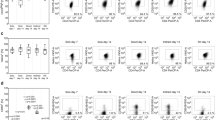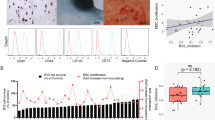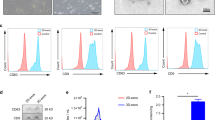Abstract
Bone marrow mesenchymal stem cells (MSCs) comprise a heterogeneous population of postnatal progenitor cells with profound immunomodulatory properties, such as upregulation of Foxp3+ regulatory T cells (Tregs) and downregulation of Th17 cells. However, it is unknown whether different MSC subpopulations possess the same range of immunomodulatory function. Here, we show that a subset of single colony-derived MSCs producing IL-17 is different from bulk MSC population in that it cannot upregulate Tregs, downregulate Th17 cells, or ameliorate disease phenotypes in a colitis mouse model. Mechanistically, we reveal that IL-17, produced by these MSCs, activates the NFκB pathway to downregulate TGF-β production in MSCs, resulting in abolishment of MSC-based immunomodulation. Furthermore, we show that NFκB is able to directly bind to TGF-β promoter region to regulate TGF-β expression in MSCs. Moreover, these IL-17+ MSCs possess anti-Candida albicans growth effects in vitro and therapeutic effect in C. albicans-infected mice. In summary, this study shows that MSCs contain an IL-17+ subset capable of inhibiting C. albicans growth, but attenuating MSC-based immunosuppression via NFκB-mediated downregulation of TGF-β.
Similar content being viewed by others
Log in or create a free account to read this content
Gain free access to this article, as well as selected content from this journal and more on nature.com
or
References
Aggarwal S, Pittenger MF . Human mesenchymal stem cells modulate allogeneic immune cell responses. Blood 2005; 105:1815–1822.
Nauta AJ, Fibbe WE . Immunomodulatory properties of mesenchymal stromal cells. Blood 2007; 110:3499–3506.
Uccelli A, Moretta L, Pistoia V . Mesenchymal stem cells in health and disease. Nat Rev Immunol 2008; 8:726–736.
Batten P, Sarathchandra P, Antoniw JW, et al. Human mesenchymal stem cells induce T cell anergy and downregulate T cell allo-responses via the TH2 pathway: relevance to tissue engineering human heart valves. Tissue Eng 2006; 12:2263–2273.
Meisel R, Zibert A, Laryea M, Gobel U, Daubener W, Dilloo D . Human bone marrow stromal cells inhibit allogeneic T-cell responses by indoleamine 2,3-dioxygenase-mediated tryptophan degradation. Blood 2004; 103:4619–4621.
Choi H, Lee RH, Bazhanov N, Oh JY, Prockop DJ . Anti-inflammatory protein TSG-6 secreted by activated MSCs attenuates zymosan-induced mouse peritonitis by decreasing TLR2/NF-kappaB signaling in resident macrophages. Blood 2011; 118:330–338.
Shi Y, Hu G, Su J, et al. Mesenchymal stem cells: a new strategy for immunosuppression and tissue repair. Cell Res 2010; 20:510–518.
Sun L, Akiyama K, Zhang H, et al. Mesenchymal stem cell transplantation reverses multiorgan dysfunction in systemic lupus erythematosus mice and humans. Stem Cells 2009; 27:1421–1432.
Gonzalez-Rey E, Anderson P, Gonzalez MA, Rico L, Buscher D, Delgado M . Human adult stem cells derived from adipose tissue protect against experimental colitis and sepsis. Gut 2009; 58:929–939.
Park MJ, Park HS, Cho ML, et al. Transforming growth factor beta-transduced mesenchymal stem cells ameliorate experimental autoimmune arthritis through reciprocal regulation of Treg/Th17 cells and osteoclastogenesis. Arthritis Rheum 2011; 63:1668–1680.
Liotta F, Angeli R, Cosmi L, et al. Toll-like receptors 3 and 4 are expressed by human bone marrow-derived mesenchymal stem cells and can inhibit their T-cell modulatory activity by impairing Notch signaling. Stem Cells 2008; 26:279–289.
Waterman RS, Tomchuck SL, Henkle SL, Betancourt AM . A new mesenchymal stem cell (MSC) paradigm: polarization into a pro-inflammatory MSC1 or an Immunosuppressive MSC2 phenotype. PLoS One 2010; 5:e10088.
Opitz CA, Litzenburger UM, Lutz C, et al. Toll-like receptor engagement enhances the immunosuppressive properties of human bone marrow-derived mesenchymal stem cells by inducing indoleamine-2,3-dioxygenase-1 via interferon-beta and protein kinase R. Stem Cells 2009; 27:909–919.
Li W, Ren G, Huang Y, et al. Mesenchymal stem cells: a double-edged sword in regulating immune responses. Cell Death Differ 2012; 19:1505–1513.
Kolls JK, Linden A . Interleukin-17 family members and inflammation. Immunity 2004; 21:467–476.
Matsuzaki G, Umemura M . Interleukin-17 as an effector molecule of innate and acquired immunity against infections. Microbiol Immunol 2007; 51:1139–1147.
Zelante T, De Luca A, Bonifazi P, et al. IL-23 and the Th17 pathway promote inflammation and impair antifungal immune resistance. Eur J Immunol 2007; 37:2695–2706.
Michel ML, Keller AC, Paget C, et al. Identification of an IL-17-producing NK1.1(neg) iNKT cell population involved in airway neutrophilia. J Exp Med 2007; 204:995–1001.
Vykhovanets EV, Maclennan GT, Vykhovanets OV, Gupta S . IL-17 Expression by macrophages is associated with proliferative inflammatory atrophy lesions in prostate cancer patients. Int J Clin Exp Pathol 2011; 4:552–565.
Takahashi N, Vanlaere I, de Rycke R, et al. IL-17 produced by Paneth cells drives TNF-induced shock. J Exp Med 2008; 205:1755–1761.
Zepp J, Wu L, Li X . IL-17 receptor signaling and T helper 17-mediated autoimmune demyelinating disease. Trends Immunol 2011; 32:232–239.
Beriou G, Costantino CM, Ashley CW, et al. IL-17-producing human peripheral regulatory T cells retain suppressive function. Blood 2009; 113:4240–4249.
Eljaafari A, Tartelin ML, Aissaoui H, et al. Bone marrow-derived and synovium-derived mesenchymal cells promote Th17 cell expansion and activation through caspase 1 activation: contribution to the chronicity of rheumatoid arthritis. Arthritis Rheum 2012; 64:2147–2157.
Mangan PR, Harrington LE, O'Quinn DB, et al. Transforming growth factor-beta induces development of the T(H)17 lineage. Nature 2006; 441:231–234.
Bettelli E, Carrier Y, Gao W, et al. Reciprocal developmental pathways for the generation of pathogenic effector TH17 and regulatory T cells. Nature 2006; 441:235–238.
Harris TJ, Grosso JF, Yen HR, et al. Cutting edge: An in vivo requirement for STAT3 signaling in TH17 development and TH17-dependent autoimmunity. J Immunol 2007; 179:4313–4317.
Yang XO, Panopoulos AD, Nurieva R, et al. STAT3 regulates cytokine-mediated generation of inflammatory helper T cells. J Biol Chem 2007; 282:9358–9363.
Morikawa S, Mabuchi Y, Kubota Y, et al. Prospective identification, isolation, and systemic transplantation of multipotent mesenchymal stem cells in murine bone marrow. J Exp Med 2009; 206:2483–2496.
Iwakura Y, Ishigame H, Saijo S, Nakae S . Functional specialization of interleukin-17 family members. Immunity 2011; 34:149–162.
Alex P, Zachos NC, Nguyen T, et al. Distinct cytokine patterns identified from multiplex profiles of murine DSS and TNBS-induced colitis. Inflamm Bowel Dis 2009; 15:341–352.
Zhang Q, Shi S, Liu Y, Uyanne J, Shi Y, Le AD . Mesenchymal stem cells derived from human gingiva are capable of immunomodulatory functions and ameliorate inflammation-related tissue destruction in experimental colitis. J Immunol 2009; 183:7787–7798.
Huang W, Na L, Fidel PL, Schwarzenberger P . Requirement of interleukin-17A for systemic anti-Candida albicans host defense in mice. J Infect Dis 2004; 190:624–631.
Akiyama K, Chen C, Wang D, et al. Mesenchymal stem cell induced immunoregulation involves FAS-ligand/FAS-mediated T cell apoptosis. Cell Stem Cell 2012; 10:544–555.
Sudres M, Norol F, Trenado A, et al. Bone marrow mesenchymal stem cells suppress lymphocyte proliferation in vitro but fail to prevent graft-versus-host disease in mice. J Immunol 2006; 176:7761–7767.
Lindner U, Kramer J, Rohwedel J, Schlenke P . Mesenchymal stem or stromal cells: toward a better understanding of their biology? Transfus Med Hemother 2010; 37:75–83.
Zhou L, Lopes JE, Chong MM, et al. TGF-beta-induced Foxp3 inhibits T(H)17 cell differentiation by antagonizing RORgammat function. Nature 2008; 453:236–240.
Svobodova E, Krulova M, Zajicova A, et al. The role of mouse mesenchymal stem cells in differentiation of naive T-cells into anti-inflammatory regulatory T-cell or proinflammatory helper T-cell 17 population. Stem Cells Dev 2012; 21:901–910.
Xu G, Zhang L, Ren G, et al. Immunosuppressive properties of cloned bone marrow mesenchymal stem cells. Cell Res 2007; 17:240–248.
Le Blanc K, Frassoni F, Ball L, et al. Mesenchymal stem cells for treatment of steroid-resistant, severe, acute graft-versus-host disease: a phase II study. Lancet 2008; 371:1579–1586.
Caccamo N, La Mendola C, Orlando V, et al. Differentiation, phenotype, and function of interleukin-17-producing human Vγ9Vδ2 T cells. Blood 2011; 118:129–138.
Auletta JJ, Deans RJ, Bartholomew AM . Emerging roles for multipotent, bone marrow-derived stromal cells in host defense. Blood 2012; 119:1801–1809.
Krasnodembskaya A, Song Y, Fang X, et al. Antibacterial effect of human mesenchymal stem cells is mediated in part from secretion of the antimicrobial peptide LL-37. Stem Cells 2010; 28:2229–2238.
Liu Y, Wang L, Kikuiri T, et al. Mesenchymal stem cell-based tissue regeneration is governed by recipient T lymphocytes via IFN-gamma and TNF-alpha. Nat Med 2011; 17:1594–1601.
Shi S, Gronthos S, Chen S, et al. Bone formation by human postnatal bone marrow stromal stem cells is enhanced by telomerase expression. Nat Biotechnol 2002; 20:587–591.
Yamaza T, Kentaro A, Chen C, et al. Immunomodulatory properties of stem cells from human exfoliated deciduous teeth. Stem Cell Res Ther 2010; 1:5.
Hathcock KS . T cell depletion by cytotoxic elimination. Curr Protoc Immunol 2001; Chapter 3:Unit 3.4.
Acknowledgements
This work was supported by grants from the National Institute of Dental and Craniofacial Research (NIDCR), National Institutes of Health (NIH), Department of Health and Human Services (R01DE017449, R01 DE019932, and R01 DE019413 to S S), the Ministry of Science and Technology of China (2010DFB32980 to Y Z), and the Intramural Research Program of NIDCR, NIH (to W J C).
Author information
Authors and Affiliations
Corresponding authors
Additional information
( Supplementary information is linked to the online version of the paper on the Cell Research website.)
Supplementary information
Supplementary information, Figure S1
Flow cytometric analysis showed that hMSCs and mMSCs expressed stem cell markers CD146 and Sca1, but not hematopoietic markers CD34, CD3, CD4 and CD8a. (PDF 1166 kb)
Supplementary information, Figure S2
Immunofluorescent and immunocytochemical staining showed that hMSCs were positive for stem cell markers CD146 and Sca1, but negative for T cell markers CD3, CD4 and CD8a. (PDF 9091 kb)
Supplementary information, Figure S3
Flow cytometric analysis showed the efficacy of CD3 antibody/complement–mediated depletion of CD3+ T cells in hPBMCs. (PDF 239 kb)
Supplementary information, Figure S4
IL-17 expression was regulated by IL-1β and IL-6 via activating Stat3 and RORγt. (PDF 642 kb)
Supplementary information, Figure S5
Flow cytometric analysis showed that IL-17+ MSCs (#2, #3, and #4) expressed stem cell markers CD146 and Sca1, but not hematopoietic markers CD34, CD3, CD4 and CD8a. (PDF 2111 kb)
Supplementary information, Figure S6
Single colony-derived hMSCs possess stem cell properties. (PDF 471 kb)
Supplementary information, Figure S7
Western blot analysis showed efficacy of IL-17, IL-17R, and IκB kinase α siRNA in hMSCs. (PDF 930 kb)
Supplementary information, Figure S8
(A) Western blot analysis showed that recombinant IL-17 treatment increased p-IκBα and p-p65 in MSCs. (PDF 214 kb)
Supplementary information, Figure S9
Schematic diagram shows the mechanism by which IL-17+ MSCs attenuate immunosuppressive capacities, but possess increased anti-C. albicans activity. (PDF 205 kb)
Supplementary information, Table S1
PCR primers (PDF 98 kb)
Rights and permissions
About this article
Cite this article
Yang, R., Liu, Y., Kelk, P. et al. A subset of IL-17+ mesenchymal stem cells possesses anti-Candida albicans effect. Cell Res 23, 107–121 (2013). https://doi.org/10.1038/cr.2012.179
Received:
Revised:
Accepted:
Published:
Issue date:
DOI: https://doi.org/10.1038/cr.2012.179
Keywords
This article is cited by
-
Exploring therapeutic avenues: mesenchymal stem/stromal cells and exosomes in confronting enigmatic biofilm-producing fungi
Archives of Microbiology (2024)
-
Mesenchymal stromal cells in the bone marrow niche consist of multi-populations with distinct transcriptional and epigenetic properties
Scientific Reports (2021)
-
IFN-γ promoted exosomes from mesenchymal stem cells to attenuate colitis via miR-125a and miR-125b
Cell Death & Disease (2020)
-
Hydrogen sulfide promotes immunomodulation of gingiva-derived mesenchymal stem cells via the Fas/FasL coupling pathway
Stem Cell Research & Therapy (2018)
-
Ecto-mesenchymal stem cells: a new player for immune regulation and cell therapy
Cellular & Molecular Immunology (2018)



